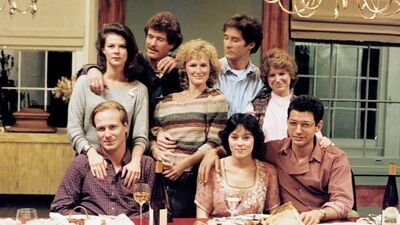I think of this as the Second-Coming-of-Age quasi-genre, in which a character, usually in their 30s, fully lets go of who they thought they would be and tries to be okay with who they appear to be. Watching this film now that I am significantly older than the characters who once seemed ancient, I can’t help but feel much of their angst is premature, that they still can be true to their younger selves. But perhaps that’s easy to say from another time and generation’s perspective.
Despite the upbeat music and the scenes of folks in their mid-30s rediscovering their youth, much of “The Big Chill” is about guilt and despair. It is a uniquely American film in that way: it makes brisk entertainment of early mid-life existential crisis (with a real accent on the word brisk because editor Carol Littleton—who will soon receive a lifetime achievement Oscar—masterfully makes this loosely plotted 105-minute film feel 25% shorter than it really is). John Bailey’s cinematography almost recalls the natural light camerawork of Néstor Almendros for Eric Rohmer (fun fact: the cinematographer and editor of “The Big Chill” were married at the time and still are as of this writing). The beauty and moodiness of the South Carolina landscape, with its sunsets and early morning fog, provide a visual narration for the collective’s state of mind. It also brings to mind Ingmar Bergman and Sven Nykvist’s collaborations if Bergman wasn’t, you know, Bergman. Kasdan loves his characters and won’t let them beat themselves up too much about their choices. One pair’s weekend infidelity is handled with such non-judgmental matter-of-factness you almost forget what year the film was made in.

Nick, played by the late William Hurt, is the most fascinating character in the bunch. Nick is the only one who hasn’t, in some ways, betrayed himself. But Nick also has a drug problem and is sexually impotent. He is thereby left out of the reunion weekend’s sexual musical chairs and, from this removed vantage point, calls out his friends on their hypocrisy. Most striking is the moment when Nick expresses revulsion at party host Harold (Kevin Kline) and his chummy relationship with the local cops (Harold is the person who owns the plantation). It is said that Nick was once a “San Francisco radio psychologist,” and watching it this time, I couldn’t help but feel Nick was being coded as queer. As if the story about the war wound that claimed his sexual potency was merely a fanciful lift from Hemingway to ward off unwanted sexual attention.
This reading is in no way thwarted by the fact that Alex’s younger girlfriend Chloe, played beautifully by Meg Tilly, who feels like she wandered in from another movie in the best way possible, chooses Nick after Jeff Goldblum’s smarmy People magazine writer Michael tries and fails to woo her. Nick’s scenes in the last act with Chloe are among the film’s most touching moments. She has chosen Nick because he is clearly the closest to Alex in his refusal to sell out to the ’80s, even if it costs him dearly. And maybe this time, Nick will find his way in a manner Alex never could.
Sumber: www.rogerebert.com
 Skip to content
Skip to content






